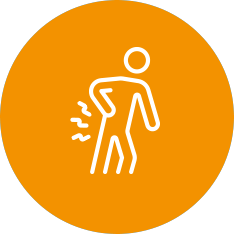Greater trochanteric pain syndrome (GTPS)
What Is Greater trochanteric pain syndrome?
Greater trochanteric pain syndrome is a common hip condition that causes pain.
It occurs when the tissues in this area become inflamed. These tissues can include tendons, muscles or bursae (fluid filled sacks).
Other names have been used to describe GTPS such as trochanteric bursitis or gluteal tendonitis but these are essentially all the same.
What are the symptoms?
- Pain around the outer hip, thigh, and bottom
- Pain with walking, standing from a chair or going uphill or stairs
- Pain when crossing the leg over the other
- Pain when the outside of the hip/thigh is pressed on – like laying on that side
- Weakness in the hip area
What are the causes?
The exact cause is not always known, but there are many factors that can contribute towards it:
- Sudden increase in load or demand placed on the muscles, such as: starting a new sport or gardening project, doing a charity walk, standing for a long time with weight on one hip
- Repetitive activities that continually overload the hip/bottom muscles
- Prolonged or excessive pressure to your hip area such as sitting long periods in chairs/seats that are too low, crossing legs or ankles, standing with weight through just one leg
- Fall or injury to the outer hip
- Inactivity causing deconditioning of the muscles and tendons
- Being a woman
- Smoking
- Being overweight
- Depression and anxiety
- Having other joint problems, such as back pain or a previous hip surgery
For more information to help support your general health and well-being, please click here to access our "Healthy You" page. This includes information on exercise, mental health, smoking and weight management.
How long will it last?
Everyone's hip pain is different and full recovery can depend on multiple factors, but most people will make a full recovery. Most people will see some improvement following 6-9 months of lifestyle changes, advice, and an exercise program. Tendon healing can be a slow process, and can take up to 18-24 months to fully resolve.
What can I do to help myself?

What else can I do?
A gradual increase in load can help the tendon structures improve. We have provided some exercises in the links below. Start with the easiest and build up to the more advanced exercises as you feel able to.
Do I need an x-ray or scan?
In most cases, no. A good history and physical examination of your hip alone provides enough information to diagnose your problem. Scans and x-rays are not always useful for diagnosing hip pain. While a scan or x-ray may provide information it rarely alters the treatment plan.
Imaging findings are very poorly linked with pain and often people with no pain have very similar findings on their scans/x-rays to those that do. X-rays and scans can help for a small number of people in certain situations and will be recommended by a healthcare professional if required.
Symptoms to check
Click the plus sign to see a list of problems that could be a sign you may need to be checked urgently
Get advice now from 111 if:
- The hip pain was caused by a serious fall or accident
- Your leg is deformed, badly bruised or bleeding
- You are unable to move your hip or bear any weight on your leg
- You have numbness or tingling around your genitals or buttocks
- You have a change to your bladder and bowel control or difficulty peeing
- You have a raised temperature and you feel unwell
- You have a fever or a rash
- Your hip pain came on very suddenly and you have sickle cell anaemia
These problems could be a sign of something more serious and may need to be checked urgently
Immediate medical advice is available by contacting NHS 111


 Hip
Hip